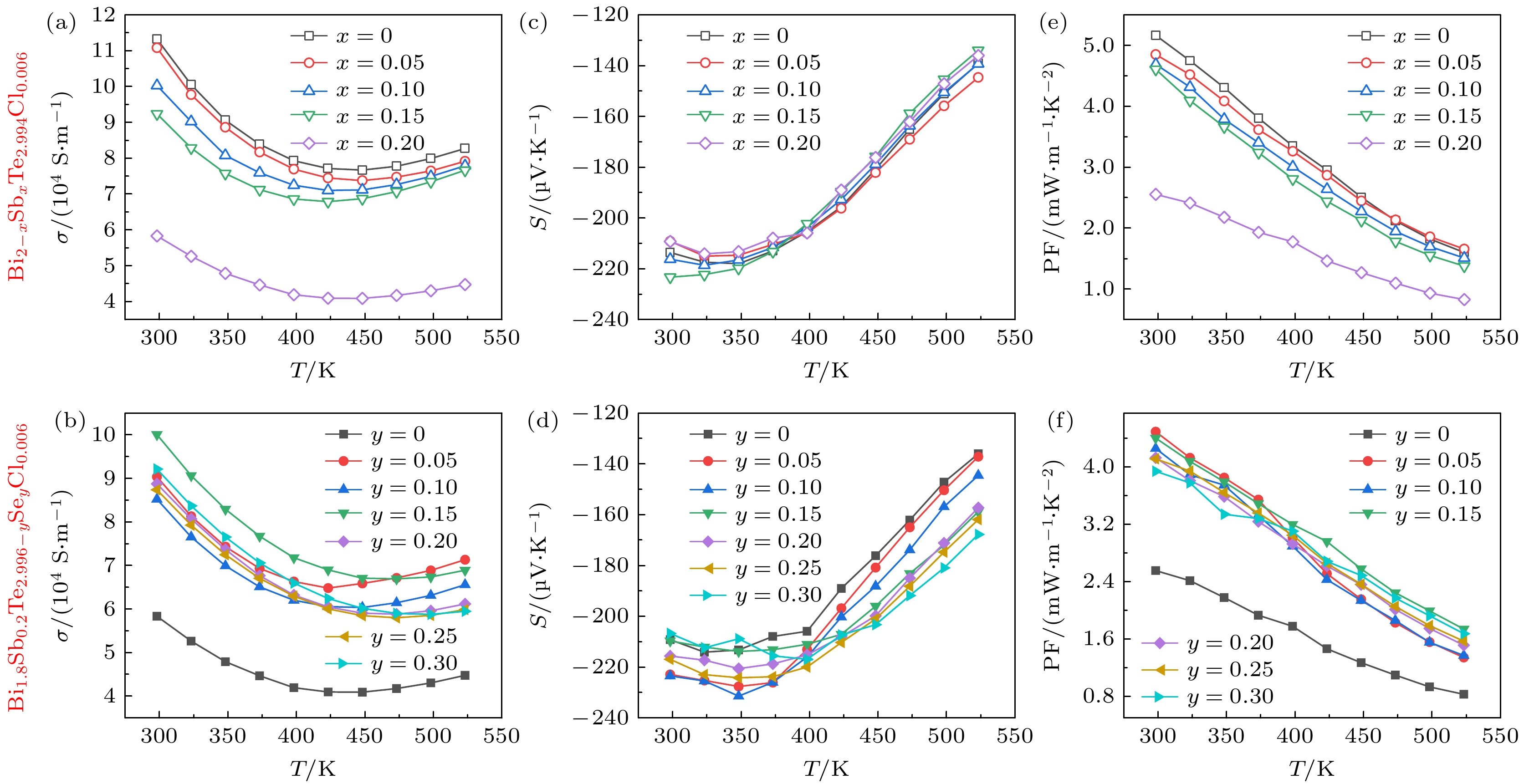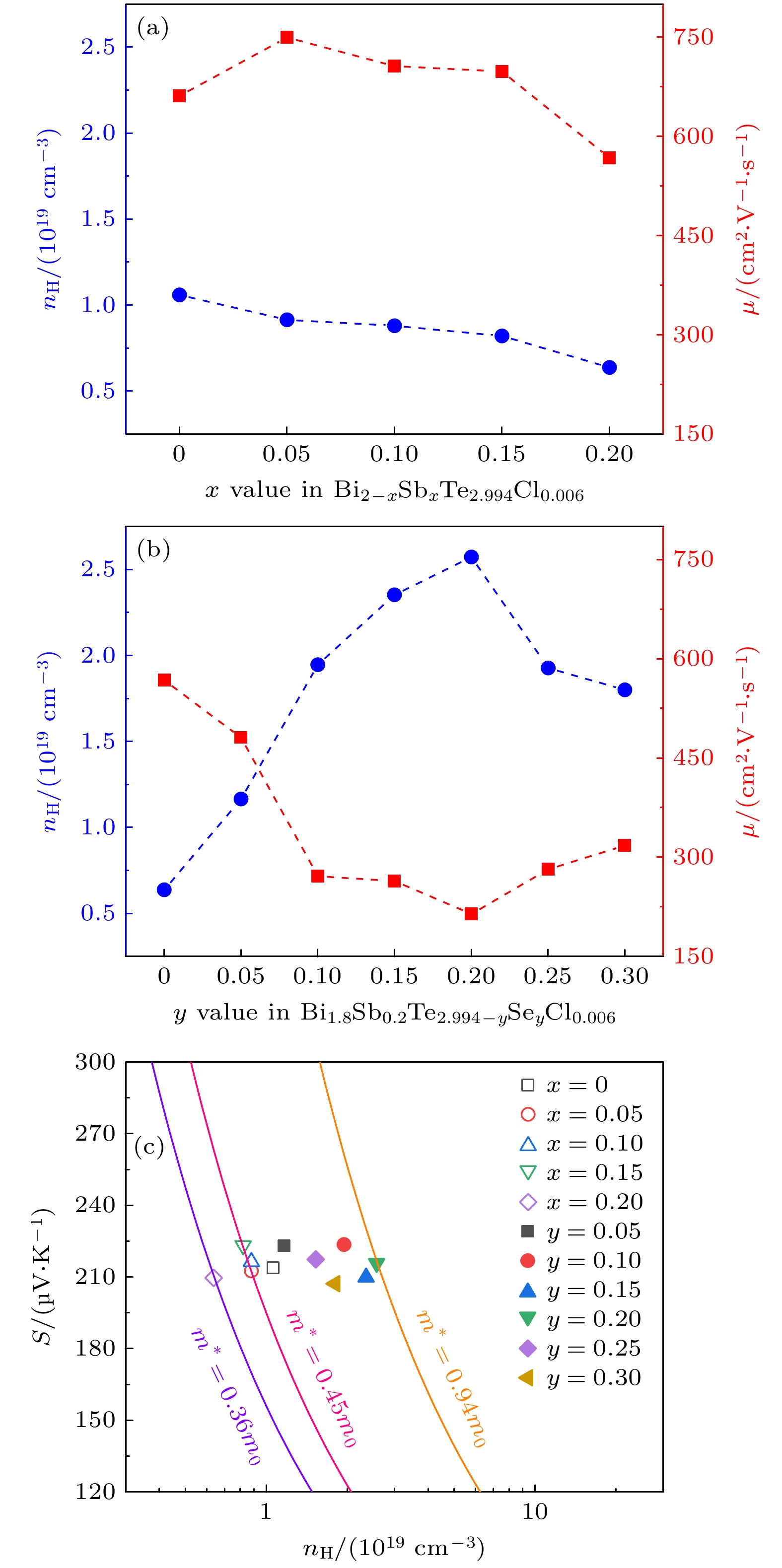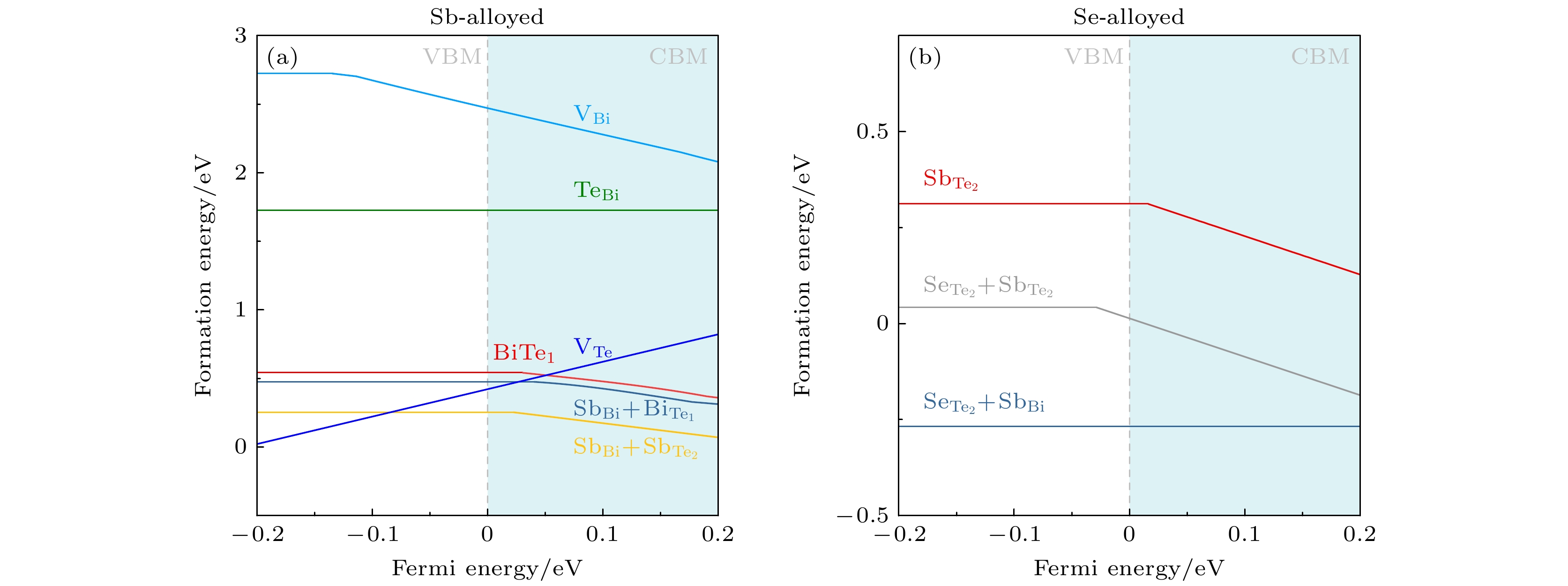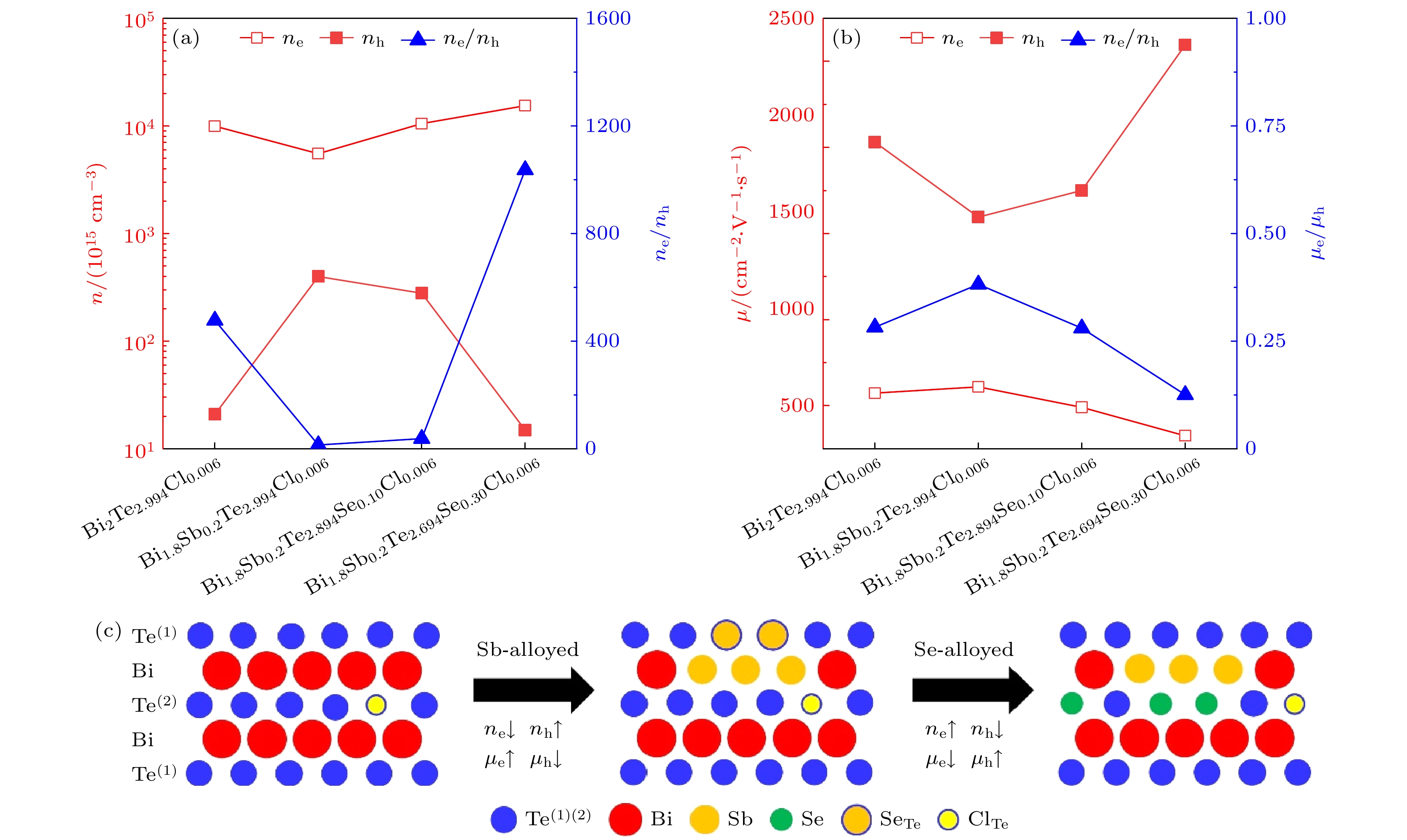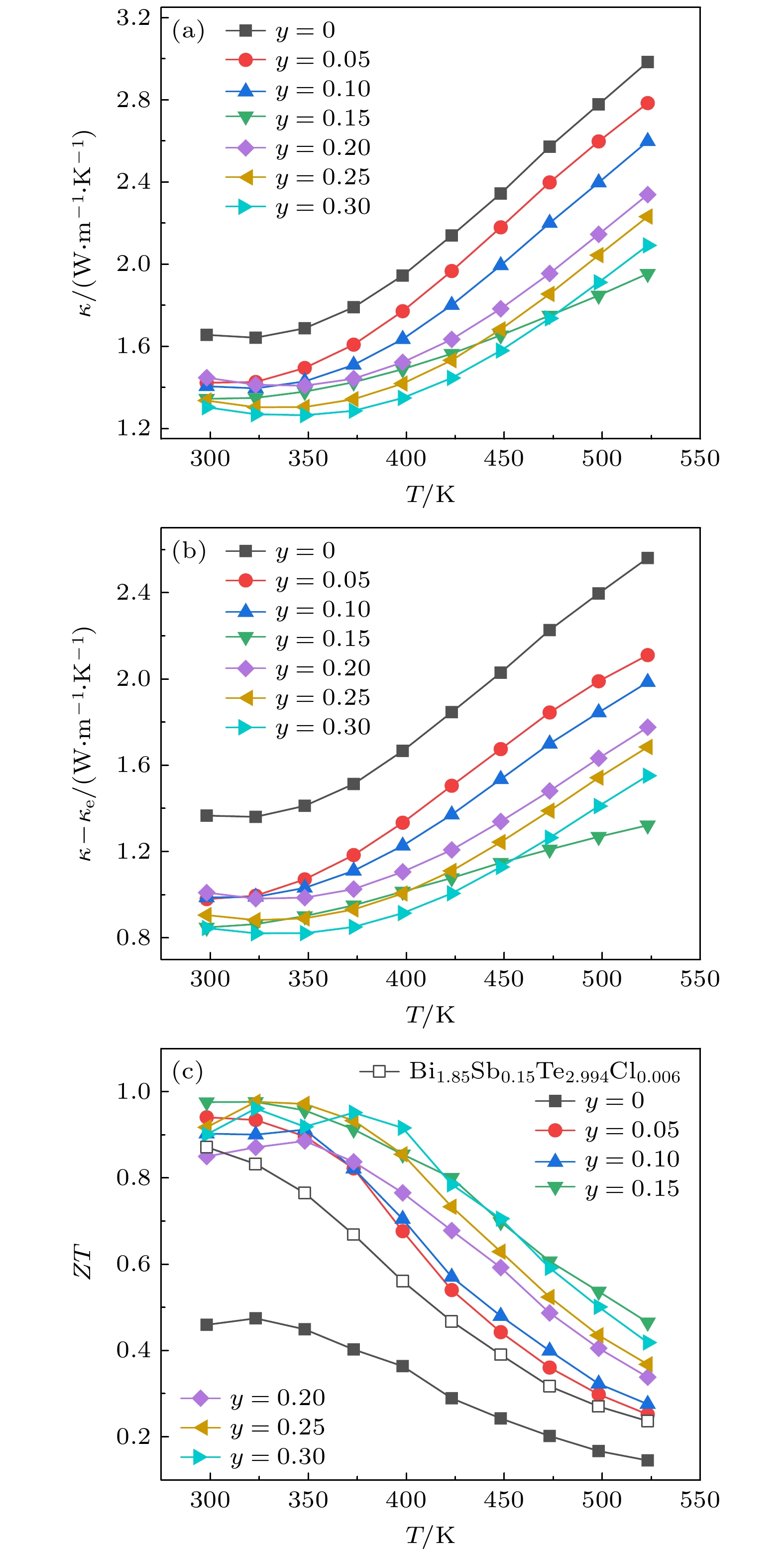-
Bi2Te3基化合物是目前室温附近性能最好的热电材料, 但其存在着大量复杂的缺陷结构, 缺陷工程是调控材料热电性能的核心手段, 因此理解和有效地调控缺陷形态和浓度是获得高性能Bi2Te3基热电材料的关键. 本文系统地研究了四元n型Bi2–x SbxTe3–ySey基化合物的缺陷演化过程及其对热电输运性能的影响规律. Sb和Se的固溶引入的带电伴生结构缺陷使得材料的载流子浓度发生了巨大变化, 在Bi2–x SbxTe2.994Cl0.006样品中, Sb的固溶降低了反位缺陷
${\mathrm{S}}{{\mathrm{b}}_{{\mathrm{T}}{{\mathrm{e}}_2}}}$ 形成能, 诱导产生了反位缺陷$ {\mathrm{S}}{{\mathrm{b}}_{{\mathrm{T}}{{\mathrm{e}}_2}}} $ , 使得少数载流子空穴浓度从2.09×1016 cm–3增加至3.99×1017 cm–3, 严重劣化了电性能. 在Bi1.8Sb0.2Te2.994–ySeyCl0.006样品中, Se的固溶使得${\mathrm{S}}{{\mathrm{e}}_{{\mathrm{T}}{{\mathrm{e}}_2}}}$ +${\mathrm{S}}{{\mathrm{b}}_{{\mathrm{Bi}}}}$ 的缺陷形成能更低, 抑制了反位缺陷${\mathrm{S}}{{\mathrm{b}}_{{\mathrm{T}}{{\mathrm{e}}_2}}}$ 的产生, Bi1.8Sb0.2Te2.694Se0.30Cl0.006样品的少数载流子空穴浓度降至1.49×1016 cm–3, 消除了其对材料热电性能的劣化效果, 显著地提升了材料的功率因子, 室温下达到4.49 mW/(m·K2). 结合Sb和Se固溶增强合金化散射降低材料的热导率, Bi1.8Sb0.2Te2.844Se0.15Cl0.006样品在室温下获得最大ZT值为0.98. 该研究为调控具有复杂成分的Bi2Te3基材料的点缺陷、载流子浓度和热电性能提供了重要的指导.-
关键词:
- Bi2Te3基化合物 /
- 缺陷工程 /
- 热电性能
Bi2Te3-based compounds are thermoelectric materials with the best performance near room temperature. The existence of a large number of complex defects makes defect engineering a core stratagem for adjusting and improving the thermoelectric performance. Therefore, understanding and effectively controlling the existence form and concentration of defects is crucial for achieving high-thermoelectric performance in Bi2Te3-based alloy. Herein, a series of Cl doped n-type quaternary Bi2–x SbxTe3–ySey compounds is synthesized by the zone-melting method. The correlation between defect evolution process and thermoelectric performance is systematically investigated by first-principles calculation and experiments. Alloying Sb on Bi site and Se on Te site induce charged structural defects, leading to a significant change in the carrier concentration. For Bi2–x SbxTe2.994Cl0.006 compounds, alloying Sb on Bi site reduces the formation energy of the${\mathrm{S}}{{\text{b}}_{{\mathrm{Te}}}}_{_2}$ antisite defect, which generates the antisite defect${\mathrm{S}}{{\text{b}}_{{\mathrm{Te}}}}_{_2}$ and accompanied with the increase of the minority carrier concentration from 2.09×1016 to 3.99×1017 cm–3. The increase of the minority carrier severely deteriorates the electrical transport properties. In contrast, alloying Se in the Bi1.8Sb0.2Te2.994–ySeyCl0.006 compound significantly lowers the formation energy of the complex defect${\mathrm{S}}{{\mathrm{e}}_{{\mathrm{Te}}}}$ +${\mathrm{S}}{{\mathrm{b}}_{{\mathrm{Bi}}}}$ , which becomes more energetically favorable and suppresses the formation of the antisite defect${\mathrm{S}}{{\text{b}}_{{\mathrm{Te}}}}_{_2}$ . As a result, the concentration of minority carriers decreases to 1.46×1016 cm–3. This eliminates the deterioration effect of the minority carrier on the electrical transport properties of the material and greatly improves the power factor. A maximum power factor of 4.49 mW/(m·K2) is achieved for Bi1.8Sb0.2Te2.944Se0.05Cl0.006 compound at room temperature. By reducing thermal conductivity through intensifying the phonon scattering via alloying Sb and Se, the maximum ZT value of 0.98 is attained for Bi1.8Sb0.2Te2.844Se0.15Cl0.006 compound at room temperature. Our finding provides an important guidance for adjusting point defects, carrier concentrations, and thermoelectric performances in Bi2Te3-based compounds with complex compositions.-
Keywords:
- Bi2Te3-based compound /
- defect engineering /
- thermoelectric properties
[1] Liu S X, Tian J L, Wu S, Zhang W, Luo M Y 2022 Nano Energy 93 106812
 Google Scholar
Google Scholar
[2] Hu B X, Shi X L, Zou J, Chen Z G 2022 Chem. Eng. J. 437 135268
 Google Scholar
Google Scholar
[3] Chen W Y, Shi X L, Zou J, Chen Z G 2022 Mater. Sci. Eng., R 151 100700
 Google Scholar
Google Scholar
[4] Han C G, Qian X, Li Q K, Deng B, Zhu Y B, Han Z J, Zhang W Q, Wang W C, Feng S P, Chen G, Liu W S 2020 Science 368 1091
 Google Scholar
Google Scholar
[5] Zhang Q, Yuan M, Pang K, Zhang Y, Wang R, Tan X, Wu G, Hu H, Wu J, Sun P, Liu G Q, Jiang J 2023 Adv. Mater. 35 2300338
 Google Scholar
Google Scholar
[6] Xie H Y, Hao S Q, Bao J K, Slade T J, Snyder G J, Wolverton C, Kanatzidis M G 2020 J. Am. Chem. Soc. 142 9553
 Google Scholar
Google Scholar
[7] Xie H, Zhao L D, Kanatzidis M G 2024 Interdiscip. Mater. 1 24
 Google Scholar
Google Scholar
[8] Liu Z, Hong T, Xu L, Wang S, Gao X, Chang C, Ding X, Xiao Y, Zhao L D 2022 Interdiscip. Mater. 2 161
 Google Scholar
Google Scholar
[9] Suh J, Yu K M, Fu D Y, Liu X Y, Yang F, Fan J, Smith D J, Zhang Y H, Furdyna J K, Dames C, Walukiewicz W, Wu J Q 2015 Adv. Mater. 27 3681
 Google Scholar
Google Scholar
[10] Tang X, Li Z, Liu W, Zhang Q, Uher C 2022 Interdiscip. Mater. 1 88
 Google Scholar
Google Scholar
[11] Medlin D L, Yang N, Spataru C D, Hale L M, Mishin Y 2019 Nat. Commun. 10 1820
 Google Scholar
Google Scholar
[12] Cheng Y, Cojocaru-Mirédin O, Keutgen J, Yu Y, Küpers M, Schumacher M, Golub P, Raty J Y, Dronskowski R, Wuttig M 2019 Adv. Mater. 31 1904316
 Google Scholar
Google Scholar
[13] Shen J J, Hu L P, Zhu T J, Zhao X B 2011 Appl. Phys. Lett. 99 124102
 Google Scholar
Google Scholar
[14] Zhu T J, Hu L P, Zhao X B, He J 2016 Adv. Sci. 3 1600004
 Google Scholar
Google Scholar
[15] Horak J, Stary Z, Lošťák P, Pancíř J 1990 J. Phys. Chem. Solids 51 1353
 Google Scholar
Google Scholar
[16] Starý Z, Horak J, Stordeur M, Stölzer M 1988 J. Phys. Chem. Solids 49 29
 Google Scholar
Google Scholar
[17] Horak J, Čermák K, Koudelka L 1986 J. Phys. Chem. Solids 47 805
 Google Scholar
Google Scholar
[18] Miller G R, Li C Y 1965 J. Phys. Chem. Solids 26 173
 Google Scholar
Google Scholar
[19] Gobrecht H, Pantzer G, Boeters K E 1964 Z. Phys. 177 68
 Google Scholar
Google Scholar
[20] Offergeld G, Van Cakenberghe J 1959 J. Phys. Chem. Solids 11 310
 Google Scholar
Google Scholar
[21] 鲁志强, 刘可可, 李强, 胡芹, 冯丽萍, 张清杰, 吴劲松, 苏贤礼, 唐新峰 2023 无机材料学报 38 1331
 Google Scholar
Google Scholar
Lu Z Q, Liu K K, Li Q, Hu Q, Feng L P, Zhang Q J, Wu J S, Su X L, Tang X F 2023 J. Inorg. Mater. 38 1331
 Google Scholar
Google Scholar
[22] 李强, 陈硕, 刘可可, 鲁志强, 胡芹, 冯丽萍, 张清杰, 吴劲松, 苏贤礼, 唐新峰 2023 物理学报 72 097101
 Google Scholar
Google Scholar
Li Q, Chen S, Liu K K, Lu Z Q, Hu Q, Feng L P, Zhang Q J, Wu J S, Su X L, Tang X F 2023 Acta Phys. Sin. 72 097101
 Google Scholar
Google Scholar
[23] Zhang Q, Cao F, Liu W, Lukas K, Yu B, Chen S, Opeil C, Broido D, Chen G, Ren Z 2012 J. Am. Chem. Soc. 134 10031
 Google Scholar
Google Scholar
[24] Mehta R J, Zhang Y L, Karthik C, Singh B, Siegel R W, Borca-Tasciuc T, Ramanath G 2012 Nat. Mater. 11 233
 Google Scholar
Google Scholar
[25] Heremans J P, Wiendlocha B, Chamoire A M 2012 Energy Environ. Sci. 5 5510
 Google Scholar
Google Scholar
[26] Pei Y Z, Heinz N A, LaLonde A, Snyder G J 2011 Energy Environ. Sci. 4 3640
 Google Scholar
Google Scholar
[27] Xie W J, Tang X F, Yan Y G, Zhang Q J, Tritt T M 2009 Appl. Phys. Lett. 94 102111
 Google Scholar
Google Scholar
[28] Navratil J, Starý Z, Plechacek T 1996 Mater. Res. Bull. 31 1559
 Google Scholar
Google Scholar
[29] Shen J J, Zhu T J, Zhao X B, Zhang S N, Yang S H, Yin Z Z 2010 Energy Environ. Sci. 3 1519
 Google Scholar
Google Scholar
[30] Oh T S, Hyun D B, Kolomoets N V 2000 Scr. Mater. 42 849
 Google Scholar
Google Scholar
[31] Hao F, Qiu P, Tang Y, Bai S, Xing T, Chu H S, Zhang Q, Lu P, Zhang T, Ren D, Chen J, Shi X, Chen L 2016 Energy Environ. Sci. 9 3120
 Google Scholar
Google Scholar
[32] Hwang J Y, Kim J, Kim H S, Kim S I, Lee K H, Kim S W 2018 Adv. Energy Mater. 8 1800065
 Google Scholar
Google Scholar
[33] Qin B, Wang D, Liu X, Qin Y, Dong J F, Luo J, Li J W, Liu W, Tan G J, Tang X F, Li J F, He J, Zhao L D 2021 Science 373 556
 Google Scholar
Google Scholar
[34] Su X L, Wei P, Li H, Liu W, Yan Y G, Li P, Su C Q, Xie C J, Zhao W Y, Zhai P C, Zhang Q J, Tang X F, Uher C 2017 Adv. Mater. 29 23
 Google Scholar
Google Scholar
[35] 陶颖, 祁宁, 王波, 陈志权, 唐新峰 2018 物理学报 67 197201
 Google Scholar
Google Scholar
Tao Y, Qi N, Wang B, Chen Z Q, Tang X F 2018 Acta Phys. Sin. 67 197201
 Google Scholar
Google Scholar
[36] 杨东旺, 罗婷婷, 苏贤礼, 吴劲松, 唐新峰 2021 无机材料学报 36 991
 Google Scholar
Google Scholar
Yang D W, Luo T T, Su X L, Wu J S, Tang X F 2021 J. Inorg. Mater. 36 991
 Google Scholar
Google Scholar
[37] Kim H S, Gibbs Z M, Tang Y L, Wang H, Snyder G J 2015 APL Mater. 3 041506
 Google Scholar
Google Scholar
[38] Witting I T, Ricci F, Chasapis T C, Hautier G, Snyder G J 2020 Research 2020 4361703
 Google Scholar
Google Scholar
-
图 1 (a) 区熔法制备Bi2–x SbxTe2.994Cl0.006和Bi1.8Sb0.2Te2.994–ySeyCl0.006样品粉末X射线衍射图谱; (b) Bi1.8Sb0.2Te2.694Se0.3Cl0.006样品垂直于提拉方向自由断裂截面的场发射扫描电子显微镜照片; (c) Bi1.8Sb0.2Te2.694Se0.3Cl0.006样品抛光表面背散射电子图像(单位原子百分比)以及对应区域Bi, Sb, Se和Te等元素的面分布图像
Fig. 1. (a) Powder XRD patterns of Bi2–x SbxTe2.994Cl0.006 and Bi1.8Sb0.2Te2.994–ySeyCl0.006 samples prepared by zone melting method; (b) field emission scanning electron microscope images of freshly fractured surfaces of the Bi1.8Sb0.2Te2.694Se0.3Cl0.006 sample measured perpendicular to the travel direction during zone melting; (c) backscattered electron image of polished surfaces for Bi1.8Sb0.2Te2.694Se0.3Cl0.006 sample and the corresponding elemental mapping images for Bi, Sb, Se and Te, respectively.
图 2 Bi2–x SbxTe2.994Cl0.006和Bi1.8Sb0.2Te2.994–ySeyCl0.006样品的电输运性能 (a), (b) 电导率; (c), (d) Seebeck系数; (e), (f) 功率因子
Fig. 2. Temperature-dependent electronic transport properties for Bi2–x SbxTe2.994Cl0.006 and Bi1.8Sb0.2Te2.994–ySeyCl0.006 samples: (a), (b) Electrical conductivity; (c), (d) Seebeck coefficient; (e), (f) power factor.
图 3 (a), (b) 室温载流子浓度及迁移率随Sb, Se含量的变化; (c) 室温下样品的塞贝克系数与载流子浓度的关系, 图中紫色实线、红色实线、黄色实线为不同态密度有效质量下基于单抛带模型计算的塞贝克系数与载流子浓度关系曲线
Fig. 3. (a), (b) Hall carrier mobility and concentration change with respect to the Sb, Se content; (c) Seebeck coefficients as a function of the charge carrier concentration at 300 K, where the colored dash lines are Pisarenko plots based on the single parabolic band model with different effective mass.
表 1 Bi2–x SbxTe2.994Cl0.006和Bi1.8Sb0.2Te2.994–ySeyCl0.006样品的室温物理性能参数
Table 1. Room-temperature physic properties of Bi2–x SbxTe2.994Cl0.006 and Bi1.8Sb0.2Te2.994–ySeyCl0.006 samples.
Samples σ/(104 S·m–1) S/(μV·K–1) n/(1019 cm–3) μ/(cm2·V–1·s–1) κ/(W·m–1·K–1) m*/m0 x = 0 11.2 –214.0 1.06 568 1.84 0.51 x = 0.05 11.0 –209.6 0.91 750 1.75 0.45 x = 0.10 9.94 –216.4 0.88 706 1.72 0.45 x = 0.15 9.16 –223.2 0.82 698 1.58 0.45 x = 0.20 5.79 –210.0 0.64 661 1.66 0.36 y = 0.05 8.97 –223.1 1.16 481 1.42 0.57 y = 0.10 8.46 –223.6 1.95 271 1.41 0.80 y = 0.15 9.94 –209.9 2.35 264 1.35 0.86 y = 0.20 8.82 –215.8 2.57 214 1.45 0.94 y = 0.25 8.68 –217.4 1.92 282 1.33 0.66 y = 0.30 9.15 –207.2 1.80 318 1.30 0.70 -
[1] Liu S X, Tian J L, Wu S, Zhang W, Luo M Y 2022 Nano Energy 93 106812
 Google Scholar
Google Scholar
[2] Hu B X, Shi X L, Zou J, Chen Z G 2022 Chem. Eng. J. 437 135268
 Google Scholar
Google Scholar
[3] Chen W Y, Shi X L, Zou J, Chen Z G 2022 Mater. Sci. Eng., R 151 100700
 Google Scholar
Google Scholar
[4] Han C G, Qian X, Li Q K, Deng B, Zhu Y B, Han Z J, Zhang W Q, Wang W C, Feng S P, Chen G, Liu W S 2020 Science 368 1091
 Google Scholar
Google Scholar
[5] Zhang Q, Yuan M, Pang K, Zhang Y, Wang R, Tan X, Wu G, Hu H, Wu J, Sun P, Liu G Q, Jiang J 2023 Adv. Mater. 35 2300338
 Google Scholar
Google Scholar
[6] Xie H Y, Hao S Q, Bao J K, Slade T J, Snyder G J, Wolverton C, Kanatzidis M G 2020 J. Am. Chem. Soc. 142 9553
 Google Scholar
Google Scholar
[7] Xie H, Zhao L D, Kanatzidis M G 2024 Interdiscip. Mater. 1 24
 Google Scholar
Google Scholar
[8] Liu Z, Hong T, Xu L, Wang S, Gao X, Chang C, Ding X, Xiao Y, Zhao L D 2022 Interdiscip. Mater. 2 161
 Google Scholar
Google Scholar
[9] Suh J, Yu K M, Fu D Y, Liu X Y, Yang F, Fan J, Smith D J, Zhang Y H, Furdyna J K, Dames C, Walukiewicz W, Wu J Q 2015 Adv. Mater. 27 3681
 Google Scholar
Google Scholar
[10] Tang X, Li Z, Liu W, Zhang Q, Uher C 2022 Interdiscip. Mater. 1 88
 Google Scholar
Google Scholar
[11] Medlin D L, Yang N, Spataru C D, Hale L M, Mishin Y 2019 Nat. Commun. 10 1820
 Google Scholar
Google Scholar
[12] Cheng Y, Cojocaru-Mirédin O, Keutgen J, Yu Y, Küpers M, Schumacher M, Golub P, Raty J Y, Dronskowski R, Wuttig M 2019 Adv. Mater. 31 1904316
 Google Scholar
Google Scholar
[13] Shen J J, Hu L P, Zhu T J, Zhao X B 2011 Appl. Phys. Lett. 99 124102
 Google Scholar
Google Scholar
[14] Zhu T J, Hu L P, Zhao X B, He J 2016 Adv. Sci. 3 1600004
 Google Scholar
Google Scholar
[15] Horak J, Stary Z, Lošťák P, Pancíř J 1990 J. Phys. Chem. Solids 51 1353
 Google Scholar
Google Scholar
[16] Starý Z, Horak J, Stordeur M, Stölzer M 1988 J. Phys. Chem. Solids 49 29
 Google Scholar
Google Scholar
[17] Horak J, Čermák K, Koudelka L 1986 J. Phys. Chem. Solids 47 805
 Google Scholar
Google Scholar
[18] Miller G R, Li C Y 1965 J. Phys. Chem. Solids 26 173
 Google Scholar
Google Scholar
[19] Gobrecht H, Pantzer G, Boeters K E 1964 Z. Phys. 177 68
 Google Scholar
Google Scholar
[20] Offergeld G, Van Cakenberghe J 1959 J. Phys. Chem. Solids 11 310
 Google Scholar
Google Scholar
[21] 鲁志强, 刘可可, 李强, 胡芹, 冯丽萍, 张清杰, 吴劲松, 苏贤礼, 唐新峰 2023 无机材料学报 38 1331
 Google Scholar
Google Scholar
Lu Z Q, Liu K K, Li Q, Hu Q, Feng L P, Zhang Q J, Wu J S, Su X L, Tang X F 2023 J. Inorg. Mater. 38 1331
 Google Scholar
Google Scholar
[22] 李强, 陈硕, 刘可可, 鲁志强, 胡芹, 冯丽萍, 张清杰, 吴劲松, 苏贤礼, 唐新峰 2023 物理学报 72 097101
 Google Scholar
Google Scholar
Li Q, Chen S, Liu K K, Lu Z Q, Hu Q, Feng L P, Zhang Q J, Wu J S, Su X L, Tang X F 2023 Acta Phys. Sin. 72 097101
 Google Scholar
Google Scholar
[23] Zhang Q, Cao F, Liu W, Lukas K, Yu B, Chen S, Opeil C, Broido D, Chen G, Ren Z 2012 J. Am. Chem. Soc. 134 10031
 Google Scholar
Google Scholar
[24] Mehta R J, Zhang Y L, Karthik C, Singh B, Siegel R W, Borca-Tasciuc T, Ramanath G 2012 Nat. Mater. 11 233
 Google Scholar
Google Scholar
[25] Heremans J P, Wiendlocha B, Chamoire A M 2012 Energy Environ. Sci. 5 5510
 Google Scholar
Google Scholar
[26] Pei Y Z, Heinz N A, LaLonde A, Snyder G J 2011 Energy Environ. Sci. 4 3640
 Google Scholar
Google Scholar
[27] Xie W J, Tang X F, Yan Y G, Zhang Q J, Tritt T M 2009 Appl. Phys. Lett. 94 102111
 Google Scholar
Google Scholar
[28] Navratil J, Starý Z, Plechacek T 1996 Mater. Res. Bull. 31 1559
 Google Scholar
Google Scholar
[29] Shen J J, Zhu T J, Zhao X B, Zhang S N, Yang S H, Yin Z Z 2010 Energy Environ. Sci. 3 1519
 Google Scholar
Google Scholar
[30] Oh T S, Hyun D B, Kolomoets N V 2000 Scr. Mater. 42 849
 Google Scholar
Google Scholar
[31] Hao F, Qiu P, Tang Y, Bai S, Xing T, Chu H S, Zhang Q, Lu P, Zhang T, Ren D, Chen J, Shi X, Chen L 2016 Energy Environ. Sci. 9 3120
 Google Scholar
Google Scholar
[32] Hwang J Y, Kim J, Kim H S, Kim S I, Lee K H, Kim S W 2018 Adv. Energy Mater. 8 1800065
 Google Scholar
Google Scholar
[33] Qin B, Wang D, Liu X, Qin Y, Dong J F, Luo J, Li J W, Liu W, Tan G J, Tang X F, Li J F, He J, Zhao L D 2021 Science 373 556
 Google Scholar
Google Scholar
[34] Su X L, Wei P, Li H, Liu W, Yan Y G, Li P, Su C Q, Xie C J, Zhao W Y, Zhai P C, Zhang Q J, Tang X F, Uher C 2017 Adv. Mater. 29 23
 Google Scholar
Google Scholar
[35] 陶颖, 祁宁, 王波, 陈志权, 唐新峰 2018 物理学报 67 197201
 Google Scholar
Google Scholar
Tao Y, Qi N, Wang B, Chen Z Q, Tang X F 2018 Acta Phys. Sin. 67 197201
 Google Scholar
Google Scholar
[36] 杨东旺, 罗婷婷, 苏贤礼, 吴劲松, 唐新峰 2021 无机材料学报 36 991
 Google Scholar
Google Scholar
Yang D W, Luo T T, Su X L, Wu J S, Tang X F 2021 J. Inorg. Mater. 36 991
 Google Scholar
Google Scholar
[37] Kim H S, Gibbs Z M, Tang Y L, Wang H, Snyder G J 2015 APL Mater. 3 041506
 Google Scholar
Google Scholar
[38] Witting I T, Ricci F, Chasapis T C, Hautier G, Snyder G J 2020 Research 2020 4361703
 Google Scholar
Google Scholar
计量
- 文章访问数: 4656
- PDF下载量: 114
- 被引次数: 0




















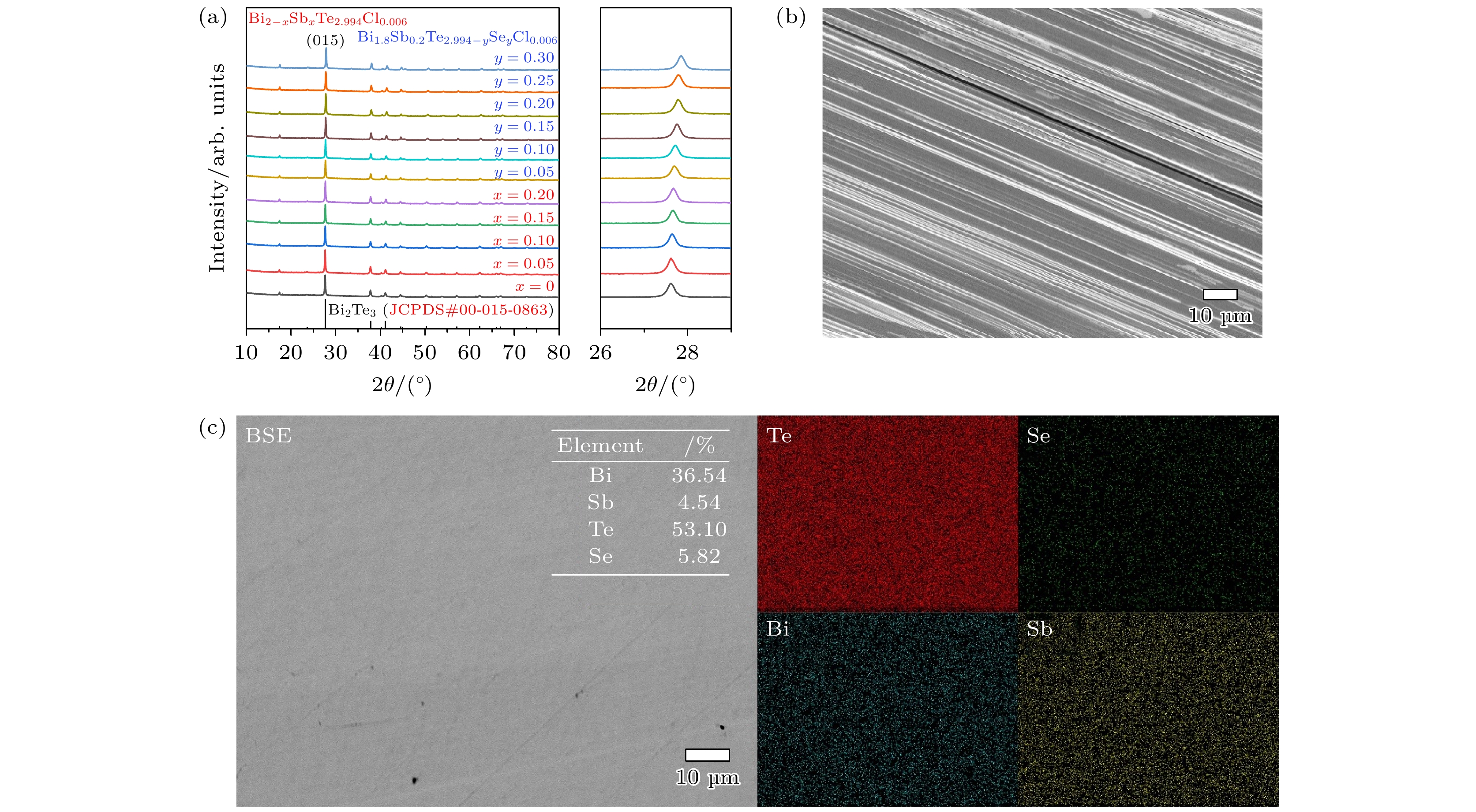
 下载:
下载:
